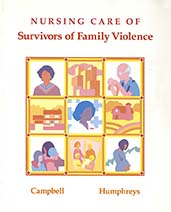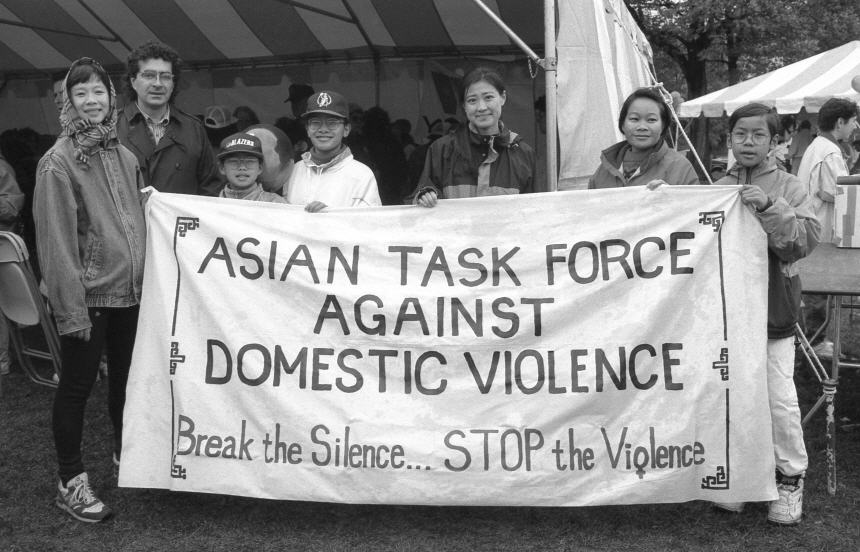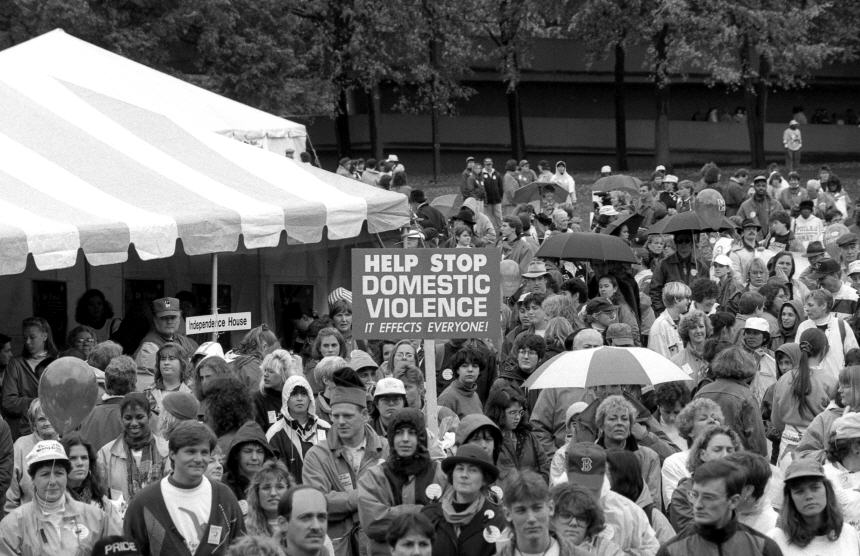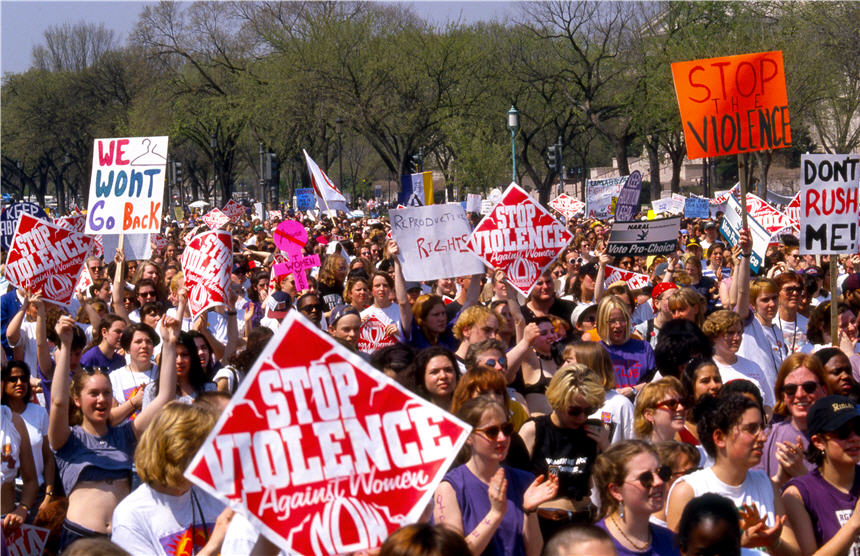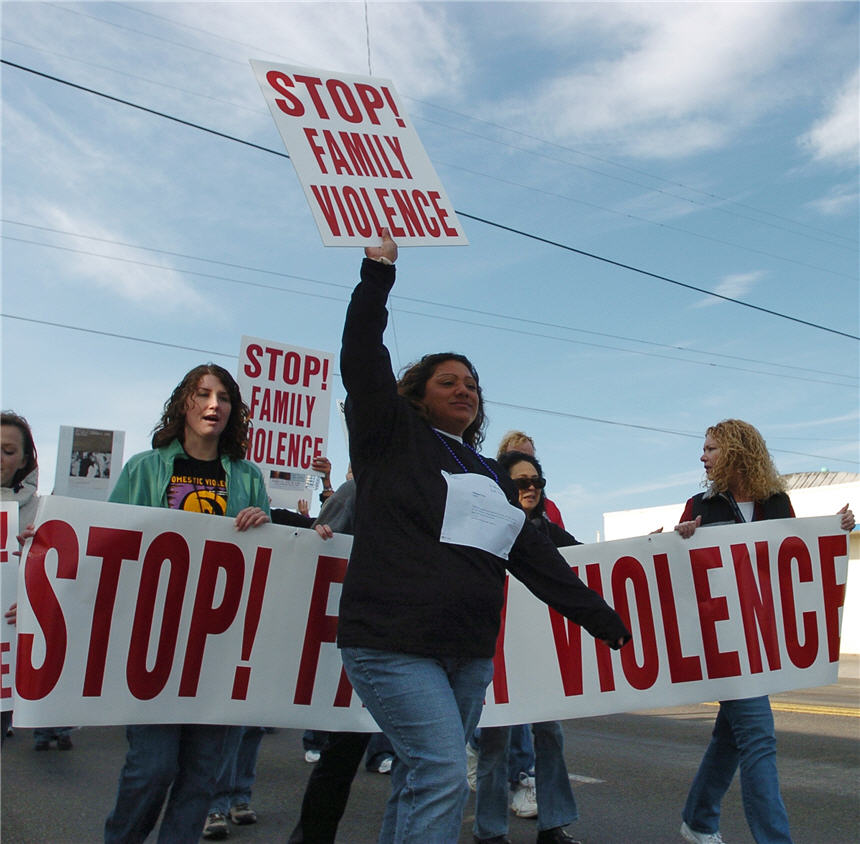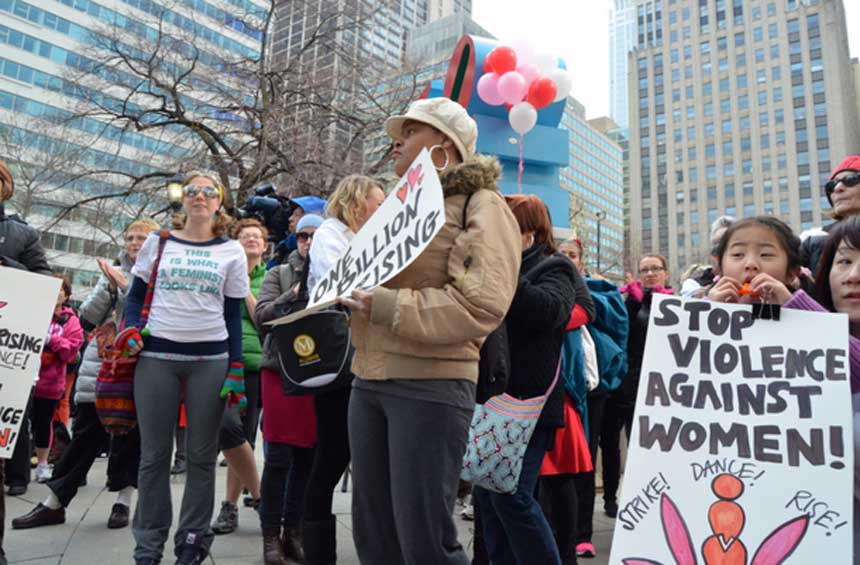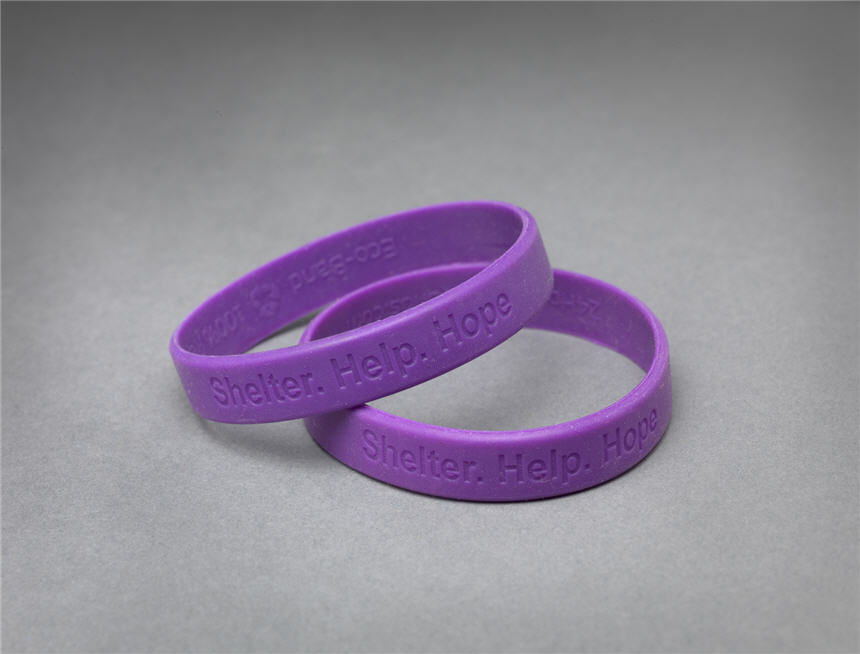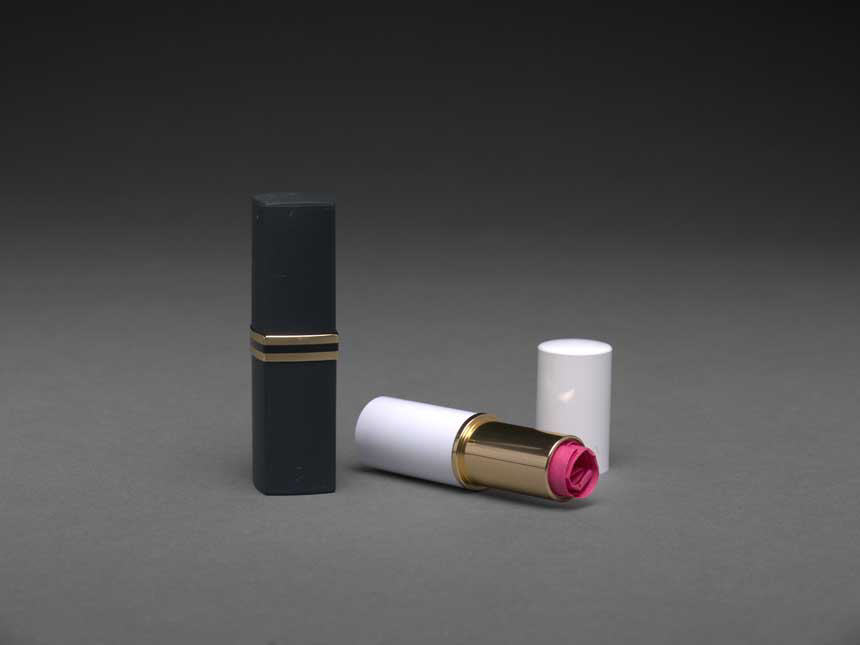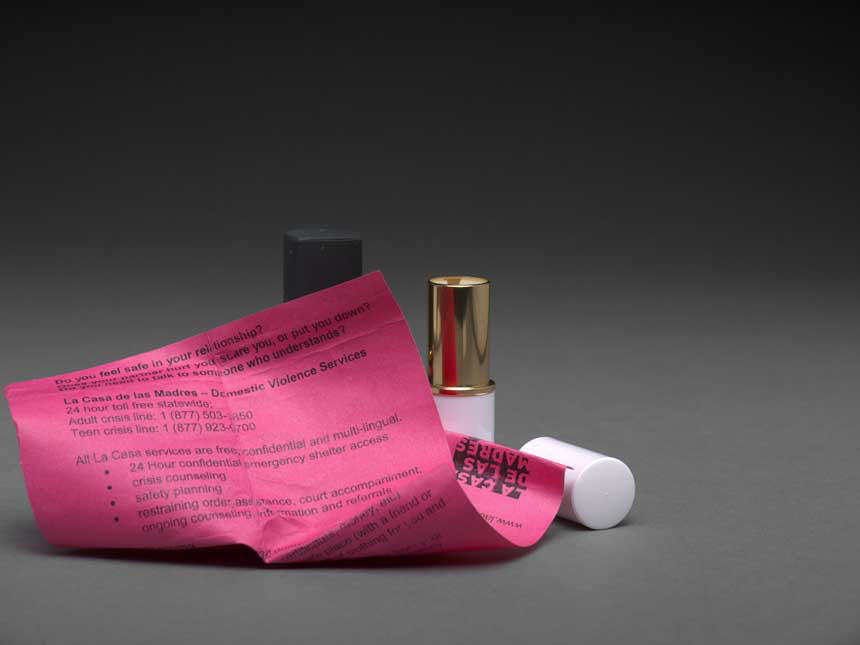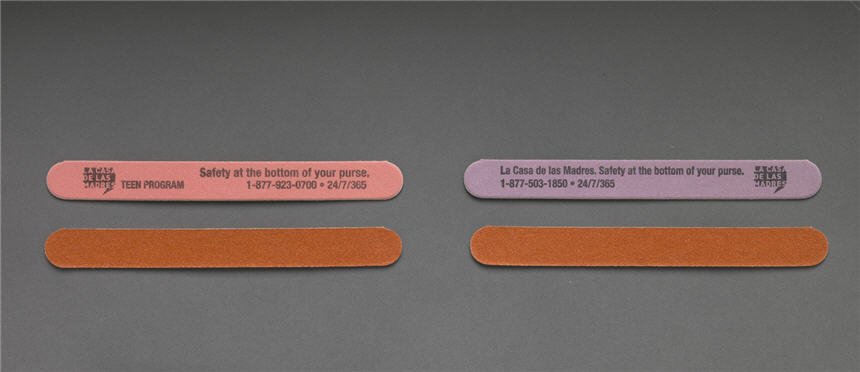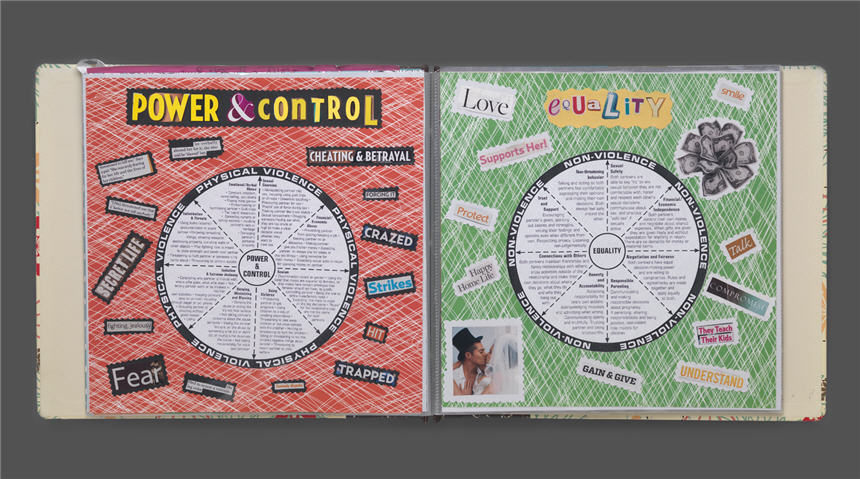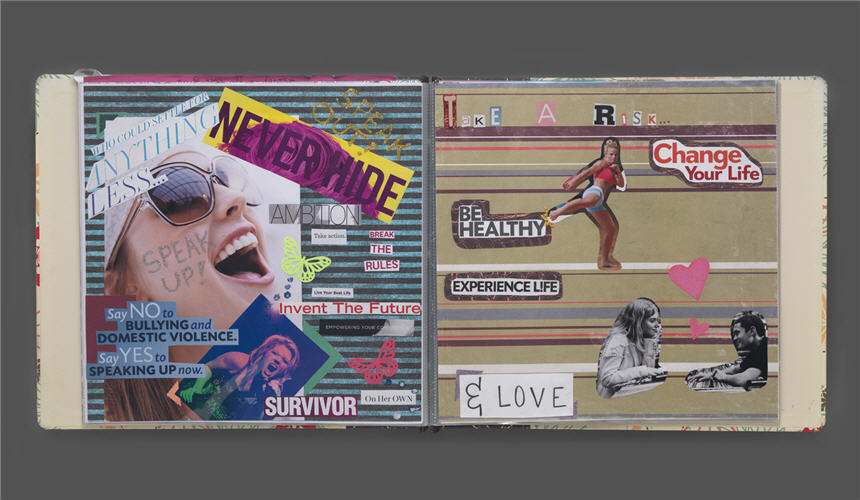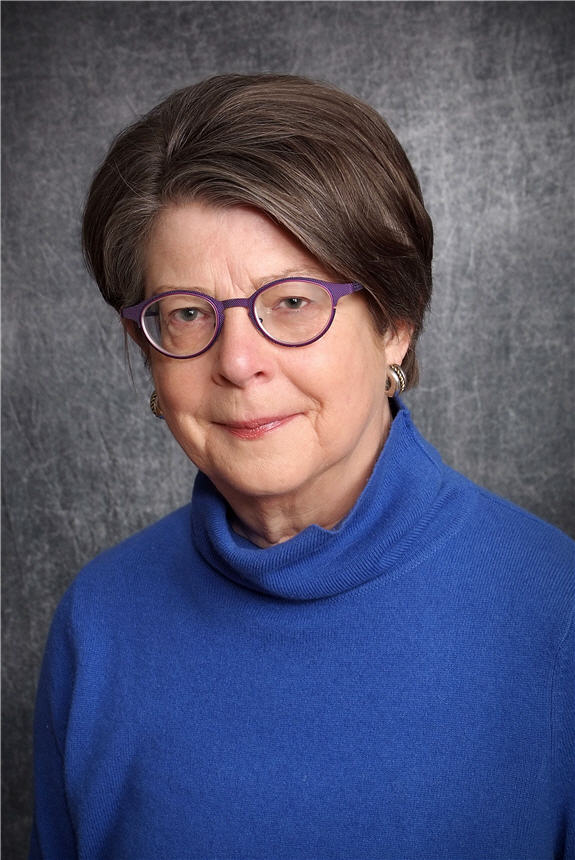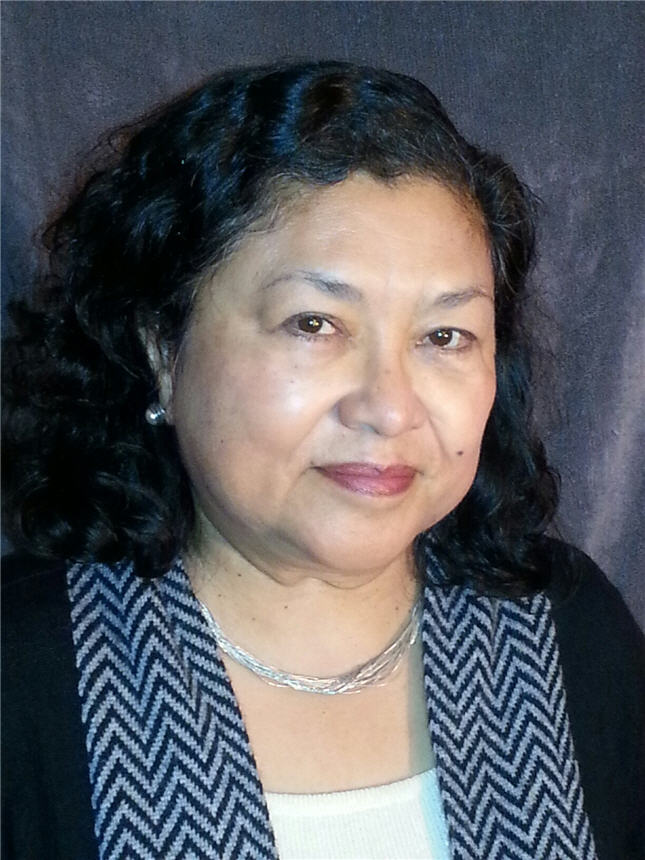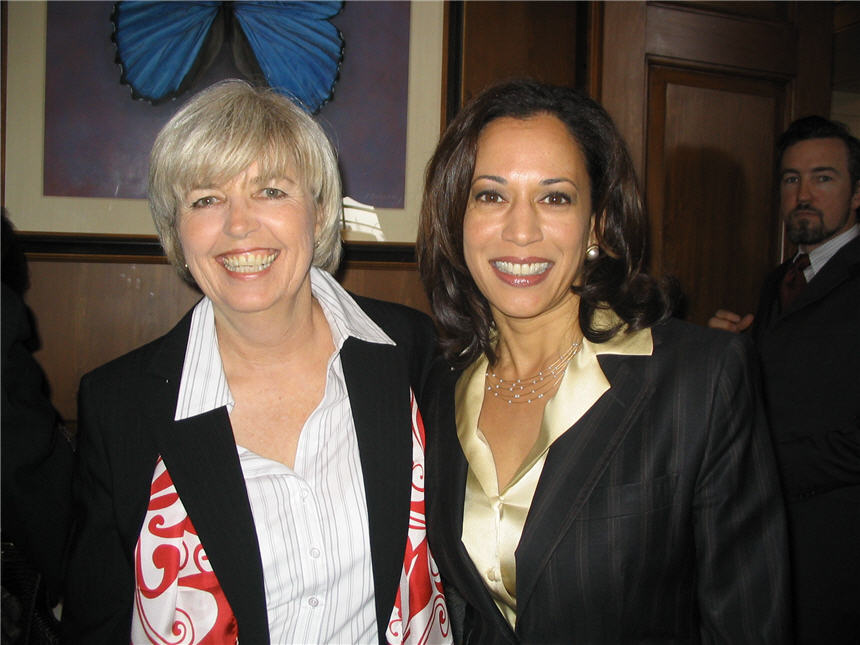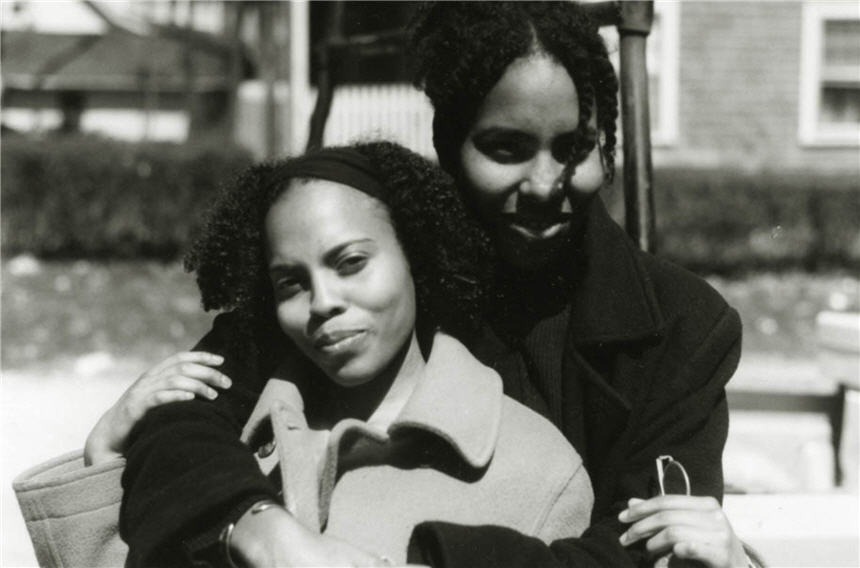Activists today continue to work tirelessly to support and empower victims of intimate partner violence. Individuals and organizations have developed innovative and creative approaches to sharing information and assisting in recovery. In the past ten years, there has been an increased focus on the specific needs of teens, immigrant women, women of color, as well as the role of men in stopping violence.
Activists with the Asian Task Force Against Domestic Violence participate in the first Jane Doe Walk for Women’s Safety in Boston, MA, 1992
©Ellen Shub 2015 all other rights reserved
As the movement against domestic violence evolved, women of color and immigrant women called attention to their specific needs.
Jane Doe Walk for Women’s Safety, Boston, MA, 1992
©Ellen Shub 2015 all other rights reserved
Men and women gathered to protest violence against women and support the Jane Doe Safety Fund, a project of the Massachusetts Coalition Against Sexual Assault and Domestic Violence.
National Organization for Women (NOW) anti-violence rally, Washington, DC, 1995
©Ellen Shub 2015 all other rights reserved
In the mid-1990s, the movement against domestic violence continued to fight for change nationwide. Across the country, activists gathered in support of victims of domestic violence and called for an end to violence.
Silvia Caward and marchers at a rally against domestic violence, Caldwell, ID, 2007
Courtesy AP Photo/Idaho Press-Tribune, Mike Vogt
Violence against women remains a critical issue in the 21st century. Activists today carry on a long tradition of advocating on behalf of survivors and rallying for a world free from violence.
“One Billion Rising” rally to end abuse against women, Philadelphia, PA, Valentine’s Day, 2013.
Courtesy Metro US
Launched on Valentine’s Day 2012, the One Billion Rising campaign is a call to action to end violence against women and girls. At the 2013 rally, people across the world came together to express their outrage, strike, dance, and speak out against the injustices women suffer, and demanded an end to violence against women.
“Shelter. Help. Hope.” support wristband, ca. 2010
Courtesy Catherine Jacquet
In the mid-2000s, silicone wristbands became a popular way for people to show support and raise awareness for various causes. The movement against domestic violence produced purple wristbands with messages of strength and support.
Lipstick tubes with resource information about La Casa de las Madres, ca. 2010
Courtesy La Casa de las Madres
La Casa de las Madres, a community organization for domestic violence victims located in San Francisco, produces and distributes lipstick tubes with a leaflet hidden inside containing information and resources about the center. These lipstick tubes are a discreet way to get information to survivors without the abuser’s knowledge.
Lipstick tubes with resource information about La Casa de las Madres, ca. 2010
Courtesy La Casa de las Madres
La Casa de las Madres, a community organization for domestic violence victims located in San Francisco, produces and distributes lipstick tubes with a leaflet hidden inside containing information and resources about the center. These lipstick tubes are a discreet way to get information to survivors without the abuser’s knowledge.
Nail files with resource information about La Casa de las Madres, ca. 2010
Courtesy La Casa de las Madres
La Casa de las Madres offers shelter, advocacy, and support to victims of domestic violence. The organization is able to discreetly get information about their services to survivors using these nail files. The files have information about the organization printed on them.
Scrapbook created by teenage girls at La Casa de las Madres’ Drop In Center during the summer of 2014
Courtesy La Casa de las Madres
La Casa de las Madres provides comprehensive and empowering services to women, teens, and children exposed to and at risk of abuse. The Scrapbook Project is open to teenage girls who have witnessed domestic violence in their homes, experienced dating violence, or want to learn more about self-expression as a source of strength. These are examples of scrapbooks created by teens in the program.
Scrapbook created by teenage girls at La Casa de las Madres’ Drop In Center during the summer of 2014
Courtesy La Casa de las Madres
La Casa de las Madres provides comprehensive and empowering services to women, teens, and children exposed to and at risk of abuse. The Scrapbook Project is open to teenage girls who have witnessed domestic violence in their homes, experienced dating violence, or want to learn more about self-expression as a source of strength. These are examples of scrapbooks created by teens in the program.
Johnny Bueno, volunteer, at La Casa de las Madres’ redHOT* kick-off event for National Domestic Violence Awareness Month, 2014
Courtesy Johnny Bueno
Johnny Bueno is preparing to speak at La Casa de las Madres’ redHOT* event. As a former victim of abuse, Bueno now volunteers at La Casa de Las Madres, using his experience to help other survivors. Bueno is one of many men who have more recently joined the movement against domestic violence.
Anne Flitcraft, MD, pioneer reformer and advocate for survivors of domestic violence, 2014
Courtesy Anne Flitcraft
As a medical student at Yale Medical School in 1975, Anne Flitcraft told her thesis advisor that she wanted to study battered women. Her advisor replied by asking her, “What’s a battered woman?” Since then, Flitcraft has committed her career and life to improving the medical response to victims of domestic violence. Amongst her many achievements, Flitcraft co-authored the American Medical Association’s Diagnostic and Treatment Guidelines on Domestic Violence (1992). Flitcraft, along with her husband Evan Stark, has worked nationally and internationally for over 40 years on behalf of survivors.
Sonia Melara, co-founder of La Casa de las Madres, ca. 2010
Courtesy Sonia Melara
Sonia Melara was one of six women who, in 1976, opened La Casa de Las Madres, California’s first shelter for women who were battered. Melara is currently a faculty member in the School of Social Work at San Francisco State University. A pioneer in the movement against domestic violence, she has over 30 years of experience in social work and community activism.
Kathy Black (left), executive director of La Casa de las Madres, and California Attorney General Kamala Harris (right) at La Casa de las Madres 30th anniversary event, 2007
Courtesy Kathy Black
Kathy Black has served as executive director of La Casa de las Madres since 1997. In her questionnaire, she shares the organizational history of La Casa, California’s first shelter for women who are battered, as well as the successes and challenges the organization faces over 30 years after its founding.
Scheherazade Tillet (left) and Salamishah Tillet, co-founders of A Long Walk Home, after a Story of a Rape Survivor performance, Boston, 2000
Courtesy Scheherazade Tillet
In 2003, sisters Scheherazade and Salamishah Tillet founded the Chicago-based national non-profit, A Long Walk Home. The organization uses art to educate, inspire, and mobilize young people to end violence against girls and women. Scheherazade is the artistic director of the Story of a Rape Survivor, a music and dance performance about a woman’s journey to recovery after being sexually assaulted in college. She is also co-creator of Girl/Friends Leadership Institutes, which are arts-based programs that empower adolescent girls in Chicago to advocate for themselves, and work towards ending violence against girls and women in their schools and communities.
Activists with the Asian Task Force Against Domestic Violence participate in the first Jane Doe Walk for Women’s Safety in Boston, MA, 1992
©Ellen Shub 2015 all other rights reserved
As the movement against domestic violence evolved, women of color and immigrant women called attention to their specific needs.
Jane Doe Walk for Women’s Safety, Boston, MA, 1992
©Ellen Shub 2015 all other rights reserved
Men and women gathered to protest violence against women and support the Jane Doe Safety Fund, a project of the Massachusetts Coalition Against Sexual Assault and Domestic Violence.
National Organization for Women (NOW) anti-violence rally, Washington, DC, 1995
©Ellen Shub 2015 all other rights reserved
In the mid-1990s, the movement against domestic violence continued to fight for change nationwide. Across the country, activists gathered in support of victims of domestic violence and called for an end to violence.
Silvia Caward and marchers at a rally against domestic violence, Caldwell, ID, 2007
Courtesy AP Photo/Idaho Press-Tribune, Mike Vogt
Violence against women remains a critical issue in the 21st century. Activists today carry on a long tradition of advocating on behalf of survivors and rallying for a world free from violence.
“One Billion Rising” rally to end abuse against women, Philadelphia, PA, Valentine’s Day, 2013.
Courtesy Metro US
Launched on Valentine’s Day 2012, the One Billion Rising campaign is a call to action to end violence against women and girls. At the 2013 rally, people across the world came together to express their outrage, strike, dance, and speak out against the injustices women suffer, and demanded an end to violence against women.
“Shelter. Help. Hope.” support wristband, ca. 2010
Courtesy Catherine Jacquet
In the mid-2000s, silicone wristbands became a popular way for people to show support and raise awareness for various causes. The movement against domestic violence produced purple wristbands with messages of strength and support.
Lipstick tubes with resource information about La Casa de las Madres, ca. 2010
Courtesy La Casa de las Madres
La Casa de las Madres, a community organization for domestic violence victims located in San Francisco, produces and distributes lipstick tubes with a leaflet hidden inside containing information and resources about the center. These lipstick tubes are a discreet way to get information to survivors without the abuser’s knowledge.
Lipstick tubes with resource information about La Casa de las Madres, ca. 2010
Courtesy La Casa de las Madres
La Casa de las Madres, a community organization for domestic violence victims located in San Francisco, produces and distributes lipstick tubes with a leaflet hidden inside containing information and resources about the center. These lipstick tubes are a discreet way to get information to survivors without the abuser’s knowledge.
Nail files with resource information about La Casa de las Madres, ca. 2010
Courtesy La Casa de las Madres
La Casa de las Madres offers shelter, advocacy, and support to victims of domestic violence. The organization is able to discreetly get information about their services to survivors using these nail files. The files have information about the organization printed on them.
Scrapbook created by teenage girls at La Casa de las Madres’ Drop In Center during the summer of 2014
Courtesy La Casa de las Madres
La Casa de las Madres provides comprehensive and empowering services to women, teens, and children exposed to and at risk of abuse. The Scrapbook Project is open to teenage girls who have witnessed domestic violence in their homes, experienced dating violence, or want to learn more about self-expression as a source of strength. These are examples of scrapbooks created by teens in the program.
Scrapbook created by teenage girls at La Casa de las Madres’ Drop In Center during the summer of 2014
Courtesy La Casa de las Madres
La Casa de las Madres provides comprehensive and empowering services to women, teens, and children exposed to and at risk of abuse. The Scrapbook Project is open to teenage girls who have witnessed domestic violence in their homes, experienced dating violence, or want to learn more about self-expression as a source of strength. These are examples of scrapbooks created by teens in the program.
Johnny Bueno, volunteer, at La Casa de las Madres’ redHOT* kick-off event for National Domestic Violence Awareness Month, 2014
Courtesy Johnny Bueno
Johnny Bueno is preparing to speak at La Casa de las Madres’ redHOT* event. As a former victim of abuse, Bueno now volunteers at La Casa de Las Madres, using his experience to help other survivors. Bueno is one of many men who have more recently joined the movement against domestic violence.
Anne Flitcraft, MD, pioneer reformer and advocate for survivors of domestic violence, 2014
Courtesy Anne Flitcraft
As a medical student at Yale Medical School in 1975, Anne Flitcraft told her thesis advisor that she wanted to study battered women. Her advisor replied by asking her, “What’s a battered woman?” Since then, Flitcraft has committed her career and life to improving the medical response to victims of domestic violence. Amongst her many achievements, Flitcraft co-authored the American Medical Association’s Diagnostic and Treatment Guidelines on Domestic Violence (1992). Flitcraft, along with her husband Evan Stark, has worked nationally and internationally for over 40 years on behalf of survivors.
Sonia Melara, co-founder of La Casa de las Madres, ca. 2010
Courtesy Sonia Melara
Sonia Melara was one of six women who, in 1976, opened La Casa de Las Madres, California’s first shelter for women who were battered. Melara is currently a faculty member in the School of Social Work at San Francisco State University. A pioneer in the movement against domestic violence, she has over 30 years of experience in social work and community activism.
Kathy Black (left), executive director of La Casa de las Madres, and California Attorney General Kamala Harris (right) at La Casa de las Madres 30th anniversary event, 2007
Courtesy Kathy Black
Kathy Black has served as executive director of La Casa de las Madres since 1997. In her questionnaire, she shares the organizational history of La Casa, California’s first shelter for women who are battered, as well as the successes and challenges the organization faces over 30 years after its founding.
Scheherazade Tillet (left) and Salamishah Tillet, co-founders of A Long Walk Home, after a Story of a Rape Survivor performance, Boston, 2000
Courtesy Scheherazade Tillet
In 2003, sisters Scheherazade and Salamishah Tillet founded the Chicago-based national non-profit, A Long Walk Home. The organization uses art to educate, inspire, and mobilize young people to end violence against girls and women. Scheherazade is the artistic director of the Story of a Rape Survivor, a music and dance performance about a woman’s journey to recovery after being sexually assaulted in college. She is also co-creator of Girl/Friends Leadership Institutes, which are arts-based programs that empower adolescent girls in Chicago to advocate for themselves, and work towards ending violence against girls and women in their schools and communities.
Activists today continue to work tirelessly to support and empower victims of intimate partner violence. Individuals and organizations have developed innovative and creative approaches to sharing information and assisting in recovery. In the past ten years, there has been an increased focus on the specific needs of teens, immigrant women, women of color, as well as the role of men in stopping violence.


